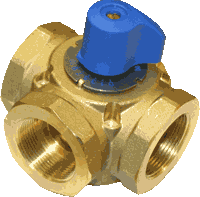Here is what I know about mixing valves - they make ANY hot water system much better for a number of reasons. 3-way or 4-way are used in most in-floor systems, but in that case the main function is often to lower the temperature of the water since most rubber tubing doesnt want water above 140.
OK, so here is how they work....picture it as one zone, since you would need one valve per zone - but in the real world, a 4-way is usually only used on the largest zone -a zone that would usually be the zone that needs heat most often (living as opposed to bedroom).
Now picture it - or draw it on a piece of paper as a figure 8. The 4-way valve is located at the middle where the lines intersect. The bottom loop is the boiler , the upper loop is the house radiation and contains a circulator.
Notes:
1. The circulator will run 100% of the time - but see Idle below
2. The valve is set at a idle setting, which for instance might circulate 180 degree water in the bottom loop (this loop is located next to the boiler and contains no radiation) and 110 degree water in the upper loop. This idle setting can easily be changed for the colder weather when you might want a higher idle.
3. On a call for heat from the thermostat, the valve starts opening slowly and now the radiation loop goes to 110, 115, 120, 125 and slowly up until the thermostat is almost satisfied (anticipator) and then the valve slowly closes back to idle.
In many scenarios the valve never opens fully nor closes fully.
The result? Lot of benefits.
1. The boiler stays at 180 and does not experience the shock of very cold water coming back into it.
2. The radiators do not creak
3. The house feels more comfortable
4. All water in the system is kept at least at the idle temperature, which does add the water in the house to the storage - at least to some level
5. Less prone to overheating because of #4.
These valves are used in the majority of European hydronic systems and they should also be used here -
People would be much happier. A good way to think about it is this - what if the cruise control on your car was the same as a regular boiler - it would floor the gas pedal when speed was needed and then provide no fuel when it was not. A better system is one that modulates the gas or heat - that is a mixing valve.
Valve with control motor removed
- Manufacturer of Mixing Valves and motorized heads;4_Way_Mixing_Valve
http://www.lkarmatur.se/en/LK-Armat...nge-LKA/EN---Termiska-ventiler--backventiler/

